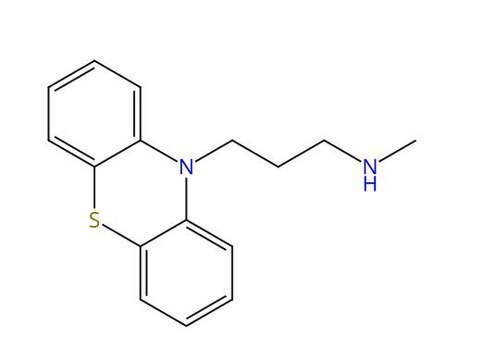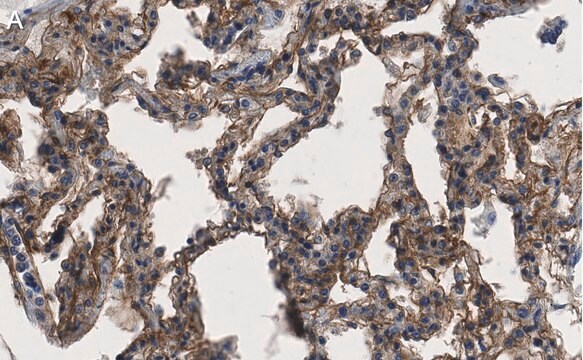推薦產品
生物源
rabbit
品質等級
重組細胞
expressed in HEK 293 cells
共軛
unconjugated
抗體表格
purified antibody
抗體產品種類
primary antibodies
無性繁殖
5L4, recombinant monoclonal
描述
recombinant, expressed in HEK 293 cells
產品線
ZooMAb® learn more
形狀
lyophilized
分子量
calculated mol wt 18.5 kDa
純化經由
using Protein A
物種活性
human, hamster
物種活性(以同源性預測)
mouse, rat
包裝
antibody small pack of 25 μL
環保替代產品特色
Waste Prevention
Designing Safer Chemicals
Design for Energy Efficiency
Learn more about the Principles of Green Chemistry.
加強驗證
recombinant expression
Learn more about Antibody Enhanced Validation
技術
immunocytochemistry: suitable
inhibition assay: suitable
western blot: suitable
同型
IgG
表位序列
N-terminal
Protein ID登錄號
UniProt登錄號
環保替代類別
運輸包裝
ambient
儲存溫度
2-8°C
基因資訊
human ... CFL1(1072)
一般說明
We are committed to bringing you greener alternative products, which adhere to one or more of The 12 Principles of Green Chemistry. This antibody is Preservative-free, produced without the harm or sacrifice of animals and exceptionally stable to allow for ambient shipping and storage if needed and thus aligns with "Waste Prevention", "Designing Safer Chemicals" and "Design for Energy Efficiency". Click here for more information.
ZooMAb® antibodies represent an entirely new generation of recombinant monoclonal antibodies. Each ZooMAb® antibody is manufactured using our proprietary recombinant expression system, purified to homogeneity, and precisely dispensed to produce robust and highly reproducible lot-to-lot consistency. Only top-performing clones are released for use by researchers. Each antibody is validated for high specificity and affinity across multiple applications, including its most commonly used application. ZooMAb® antibodies are reliably available and ready to ship when you need them.
特異性
Clone 5L4 is a ZooMAb® rabbit recombinant monoclonal antibody that specifically detects phospho-Cofilin-1 (Ser3).
免疫原
KLH-conjugated linear peptide corresponding to 10 amino acids surrounding phosphoserine 3 in human Cofilin-1.
應用
Quality Control Testing
Evaluated by Western Blotting in lysate from HeLa cells treated with Nocodazole.
Western Blotting Analysis (WB): A 1:1,000 dilution of this antibody detected phosphor-cofilin (Ser3) in lysate from overnight serum starved HeLa cells treated with Nocodazole (40 ng/mL; 8 h), but not in untreated cells.
Tested Applications
Western Blotting Analysis: A 1:1,000 dilution from a representative lot detected phospho-Cofilin (Ser3) in lysate from Chinese Hamster Ovary (CHO) cells, overnight serum starved and treated with Nocodazole (100 nM; 18 h).
Immunocytochemistry Analysis: A 1:100 dilution from a representative lot detected phospho-Cofilin (ser3) in MCF-7 cells, but not in cells treated with phosphorylated Cofilin (Ser3).
Peptide Inhibition Assay: Target band detection in lysate from HeLa cells treated with Nocodazole (40 ng/mL; 8 h) was prevented by pre-blocking of a representative lot with the immunogen phospho-peptide, but not the corresponding non-phospho-peptide.
Note: Actual optimal working dilutions must be determined by end user as specimens, and experimental conditions may vary with the end user.
Evaluated by Western Blotting in lysate from HeLa cells treated with Nocodazole.
Western Blotting Analysis (WB): A 1:1,000 dilution of this antibody detected phosphor-cofilin (Ser3) in lysate from overnight serum starved HeLa cells treated with Nocodazole (40 ng/mL; 8 h), but not in untreated cells.
Tested Applications
Western Blotting Analysis: A 1:1,000 dilution from a representative lot detected phospho-Cofilin (Ser3) in lysate from Chinese Hamster Ovary (CHO) cells, overnight serum starved and treated with Nocodazole (100 nM; 18 h).
Immunocytochemistry Analysis: A 1:100 dilution from a representative lot detected phospho-Cofilin (ser3) in MCF-7 cells, but not in cells treated with phosphorylated Cofilin (Ser3).
Peptide Inhibition Assay: Target band detection in lysate from HeLa cells treated with Nocodazole (40 ng/mL; 8 h) was prevented by pre-blocking of a representative lot with the immunogen phospho-peptide, but not the corresponding non-phospho-peptide.
Note: Actual optimal working dilutions must be determined by end user as specimens, and experimental conditions may vary with the end user.
標靶描述
Cofilin-1 (UniProt P23528; also known as 18 kDa phosphoprotein, Cofilin non-muscle isoform, p18) is encoded by the CFL1 (also known as CFL) gene (Gene ID 1072) in human. Cofilin is an actin-binding protein that regulates filament dynamics and depolymerization. Cofilin-1 (non-muscle cofilin), cofilin-2 (muscle cofilin), and actin-depolymerizing factor (ADF) play an essential role in regulating actin filament dynamics and reorganization by stimulating the severance and depolymerization of actin filaments. The three cofilin family members share 70% to 81% sequence identity, exhibit similar biological functions, and display distinct but overlapping expression patterns. Cofilins and ADF bind actin monomers and filaments (G-actin and F-actin) and increase the number of actin monomers and filament fragments, facilitating filament turnover and treadmilling at key locations in migrating cells. Cofilins and ADF are inactivated by phosphorylation at serine 3 by LIM-kinases (LIMK) and testicular protein kinases (TESKs) and are reactivated by dephosphorylation by the slingshot (SSH) family of protein phosphatases and chronophin. Cofilin-1 is required for the centralization of the mitotic spindle and symmetric division of zygotes. It also plays a role in the regulation of cell morphology and cytoskeletal organization in epithelial cells and is shown to be essential for neural tube morphogenesis and neural tube cell migration. Cfl1-knockout mice display embryonic lethality at E11.5 - E12.5 due to aberrant neural tube closure and defective neural crest cell migration, while Adf-deficient mice are viable with normal brain appearance but suffer from corneal defects that cause blindness in adult mice. Over-expression of cofilins is observed in various cancers where it promotes cancer metastasis by regulating cytoskeletal reorganization, lamellipodium formation, and epithelial-to-mesenchymal transition. This ZooMAb® recombinant monoclonal antibody, generated by our propriety technology, offers significantly enhanced specificity, affinity, reproducibility, and stability over conventional monoclonals. (Ref.: Xu, J., et al. (2021). Front. Cell Dev. Biol. 9; 599065; Yeoh, S., et al. (2002). J. Mol. Biol. 315(4); 911-925).
外觀
Purified recombinant rabbit monoclonal antibody IgG, lyophilized in PBS, 5% Trehalose, normal appearance a coarse or translucent resin. The PBS/trehalose components in the ZooMAb formulation can have the appearance of a semi-solid (bead like gel) after lyophilization. This is a normal phenomenon. Please follow the recommended reconstitution procedure in the data sheet to dissolve the semi-solid, bead-like, gel-appearing material. The resulting antibody solution is completely stable and functional as proven by full functional testing. Contains no biocide or preservatives, such as azide, or any animal by-products. Larger pack sizes provided as multiples of 25 µL.
重構
300 µg/mL after reconstitution at 25 µL per vial. Please refer to guidance on suggested starting dilutions and/or titers per application and sample type.
儲存和穩定性
Recommend storage of lyophilized product at 2-8°C; Before reconstitution, micro-centrifuge vials briefly to spin down material to bottom of the vial; Reconstitute each vial by adding 25 µL of filtered lab grade water or PBS; Reconstituted antibodies can be stored at 2-8°C, or -20°C for long term storage. Avoid repeated freeze-thaws.
其他說明
Concentration: Please refer to the Certificate of Analysis for the lot-specific concentration.
法律資訊
ZooMAb is a registered trademark of Merck KGaA, Darmstadt, Germany
免責聲明
Unless otherwise stated in our catalog or other company documentation accompanying the product(s), our products are intended for research use only and are not to be used for any other purpose, which includes but is not limited to, unauthorized commercial uses, in vitro diagnostic uses, ex vivo or in vivo therapeutic uses or any type of consumption or application to humans or animals.
未找到適合的產品?
試用我們的產品選擇工具.
儲存類別代碼
11 - Combustible Solids
水污染物質分類(WGK)
WGK 1
閃點(°F)
Not applicable
閃點(°C)
Not applicable
我們的科學家團隊在所有研究領域都有豐富的經驗,包括生命科學、材料科學、化學合成、色譜、分析等.
聯絡技術服務






